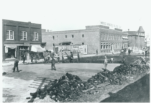Science Smarts: A vortex in your hands
By PATTY ROOKS on June 5, 2021.
This has been a busy week as we prepare for our last session with the Redcliff Public Library on Tuesday. I have thoroughly enjoyed connecting with the residents of this community in order to share my love of science with them! What a great group of families we have had each and every month come out and participate, thank you. Of course, I had way too many activities to do for next week, so here is a sneak peak at the theme of the evening. Let’s get started! Remember to ask an adult before doing this experiment. Materials • 2 empty clear pop bottles with lids (I like 500mL for small hands and 2L for older children) • Water • Drill • 3/8″ drill bit • Good strong glue • Small piece of sand paper • Duct tape • Scissors • Adult helper • Glitter or small buildings/animals (optional) Procedure • Thoroughly rinse the pop bottles and lids out so there is no more sticky pop in them! • Take the lids from the pop bottles. Using the sand paper, rub the flat side of the lid. You want to make them quite rough as this allows the glue to adhere better (in my opinion!). • Glue the two lids together – flat sides to flat sides. Use a really good strong glue to stick these together. I also like to put a bead of glue all around the outside of the caps just for added stability. They are going to be put to the test, so you want them to be good and solid. Allow the glue to set and harden for a little while. • For added protection from leaks or in case the glue does not hold (trust me, it happens!) I like to run a few strips of duct tape around the centre of this cap pushing it on there TIGHTLY. Use the scissors to cut it to the correct size. • Ask an adult to drill a 3/8″ hole in the middle of the lids that you glued together. Place it on a nice flat sturdy surface so you get a nice even hole all of the way through. This can be tough going through both lids so be CAREFUL • Fill one of the bottles about ½ full of water. • If you wish, add a small shake of glitter or some small plastic toy animals. This is optional (but fun to watch). • Carefully screw the tops onto the full water bottle. • Put the empty water bottle on top. • Make sure the bottles are secured tightly. • Flip the bottles over and rapidly rotate the bottles in a horizontal circle a few times. Set on the counter and observe what happens. What is going on? When you turn the bottles upside down, you should have observed a funnel shape or tornado! This vortex forms as the water flows from the top bottle to the lower bottle. When you rotate the bottles, the water in the upper bottle starts to rotate. As the water rotates, a force is acting upon it – centripetal force. This centripetal force pulls the water toward the centre of the bottle, and then gravity kicks in as it helps pull the water throughout the hole in you drilled in the lids. As the water drains into the bottom bottle, you should see the vortex forming. This of course this only LOOKS like a tornado. A tornado is actually formed from a thunderstorm in a cumulonimbus cloud. The perfect combination for a thunderstorm is warm moist air meeting up with some cool dry air. As these two air masses meet, they create a great deal of instability in the atmosphere. A change in the wind direction and speed at high altitudes then allows the air to move horizontally. The rising air from the ground pushes up on the swirling air stretching the cloud longer and toward the ground with a funnel-like appearance. Once this funnel cloud touches the ground it is called a tornado! Keep your eyes out this summer; you never know what you may see! Patty Rooks, Senior Scientific Consultant PRAXIS, “Connecting Science To The Community”. Contact Praxis at praxis@praxismh.ca, http://www.praxismh.ca, Tweet or follow us @PraxisMedHat, or friend us on Facebook. NOTE our NEW address: #12 826 11 Street S. E., Medicine Hat, Alberta, T1A 1T7 Phone: 403-527-5365, email: praxis@praxismh.ca. 31-30




